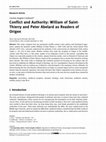Books by Carmen Angela Cvetkovic

This book examines the way in which two twelfth century authors, the Cistercian monks, Bernard of... more This book examines the way in which two twelfth century authors, the Cistercian monks, Bernard of Clairvaux (1091-1153) and William of St. Thierry (c. 1080-1148), used the works of the influential Augustine of Hippo (354-430) in the articulation of their mystical thought. The approach to this subject takes into account the fact that in the works of these authors the “mystical” element is inescapably entangled with their theological discourse and that an accurate understanding of their views on the soul’s direct encounter with God cannot be achieved without a discussion of their theology.
This book argues that the cohesion of Bernard’s and William’s mystical thought lies in their appropriation of what has been called the “guiding principle of Augustine’s mystical theology” (Louth, 2006): “You made us towards yourself and our heart is restless until it rests in you” (Confessiones 1.1.1). In Augustine’s thought this principle is reflected in the subtle interplay of three main themes, namely (1) the creation of humanity in the image and likeness of God, which provides the grounds for the understanding of the soul’s search for direct contact with God; (2) love as a longing innate in every human being, which represents the means to attain immediacy with God; and (3) the soul’s direct encounter with God, which explains the nature of the soul’s immediate consciousness of the divine presence that can only be achieved in lasting fullness at the end of time. In order to demonstrate Bernard’s and William’s dependence on Augustine, each part of the present book is structured on the basis of these three core themes which, in my view, form the scaffolding of the mystical thought of the two Cistercian authors.
As close collaborators and intimate friends, Bernard and William constantly inspired and supported each other in their theological activities. Their interests were so similar that for centuries some of William’s works were confused with those of Bernard, circulating and reaching fame under his friend’s name. However, in spite of their treatment of the same themes and in spite of developing their thought along the lines established by Augustine, investigating the specific methods of their reception of Augustine will highlight the originality and uniqueness of each of the two Cistercian authors, who while drawing on the same patristic source use it nevertheless in various ways, by focusing on different aspects of Augustine’s immense oeuvre and by arriving at distinct mystical programmes.
Edited volumes by Carmen Angela Cvetkovic
Episcopal Networks in Late Antiquity: Connection and Communication across Boundaries, 2019
The rise of the Christian bishop as a key figure of authority in Late Antiquity depended heavily ... more The rise of the Christian bishop as a key figure of authority in Late Antiquity depended heavily on the episcopal ability to mobilize and manipulate personal networks both locally and globally. This volume explores the nature, quality and breadth of various types of episcopal relationships in order to understand how they were established , cultivated or put to use across cultural, social, administrative and geographic boundaries.
Twelfth century Latin West by Carmen Angela Cvetkovic
Studia Anselmiana, 2024
Bernard of Clairvaux was a highly controversial figure during his lifetime and he has remained so... more Bernard of Clairvaux was a highly controversial figure during his lifetime and he has remained so until today, being famously named by Brian Patrick McGuire, one of the most prominent Bernardine scholars, a “difficult saint.” During his lifetime he had many admirers and followers, but his habit of meddling in and trying to control ecclesiastical affairs also earned him numerous enemies. Yet when the writing of his Vita was undertaken with the well-defined aim of the abbot of Clairvaux’s canonization, the focus was entirely on representing Bernard as a holy man. This paper examines the various ways in which Bernard’s holiness was represented in the first book of the Vita Prima written by his friend and theological collaborator William of St Thierry.

Cistercian Mysticism, 2024
For William of St Thierry (c. 1080-1148) to be a monk meant to live a life of constant search for... more For William of St Thierry (c. 1080-1148) to be a monk meant to live a life of constant search for direct contact with God. In his works he described often from different perspectives what entailed such a direct encounter with God. Thus, he talked about tasting God, enjoying God, loving God and about union with God. In addition, following in the footsteps of his Christian predecessors, in particular Augustine, William described frequently the soul’s encounter with God as vision. However, in modern scholarship William’s notion of seeing God has not been much discussed. Therefore the aim of this paper is to explore William’s view on visio Dei, a topic that preoccupied him from his very first work, entitled De Contemplando Deo and that remained a constant interest throughout his theological career, being discussed again in Meditativae orationes and especially in the mature treatise Aenigma fidei. This paper will inquire, among others, whether, according to William, it is possible for the human beings to see God in this life, and if so, under which circumstances; why is William urging his fellow monks to seek the very face of God, and what are the effects of the vision of God, if any, on the life of monks.

Open Theology, 2021
This study compares how two prominent twelfth-century Latin authors and theological opponents, na... more This study compares how two prominent twelfth-century Latin authors and theological opponents, namely the monastic author William of Saint-Thierry (c. 1080-1148) and the school master Peter Abelard (1079-1142), variously understood the authority of the controversial yet influential Greek author Origen (c. 184-253) in their works. Modern scholars who study the reception of Origen in the twelfthcentury Latin West have, to this point, spoken of an Origenian revival in this period, concluding that Origen was especially popular in the cloister, among Cistercian monks, such as Bernard of Clairvaux and his followers, like William of Saint-Thierry, based on the assumption that as monks they found his writings more relevant. This study seeks to challenge this scholarly narrative by focusing on two authors who are perceived as typifying two different strands of theology, one of a contemplative character developed in the cloister (William) and one making use of dialectics and developed in the emerging schools (Abelard). By demonstrating that the schoolmaster Abelard drew on Origen to a greater degree and in a more transparent manner than his monastic opponent, this study will show that Origen's popularity in the cloisters was not, as such, a clear point of distinction between them and schools in the way that has usually been claimed by modern scholarship.

Cîteaux , 2018
The expression sensus amoris is used by William to refer to a superior type of knowledge whose ob... more The expression sensus amoris is used by William to refer to a superior type of knowledge whose object is God. In developing his view, it has been claimed that William follows primarily Greek authors such as Origen and Gregory of Nyssa, and among Latin authors, Gregory the Great. The aim of this paper is to challenge this scholarly position to some extent and to identify Augustine as William’s main source, focusing on passages from three main texts: the Meditationes, the Speculum fidei, and the Expositio super Cantica Canticorum. This article argues that in describing the mechanism of sensus amoris, William relied on Augustine’s theory of sense perception as presented especially in the latter’s De Trinitate. As Augustine never uses the expression sensus amoris, this paper will also attempt to discern William’s innovative contribution to the understanding of this important notion for his mystical theology.

Adamantius, 2018
It is widely acknowledged nowadays that Origen reigns supreme among the Greek sources of the twel... more It is widely acknowledged nowadays that Origen reigns supreme among the Greek sources of the twelfth century Latin authors. The growing interest in Origen’s works during this period has been directly connected with the monastic revival and, in particular, with the name of Bernard of Clairvaux. Considered commonly as a follower of Origen in his works, Bernard has been identified as the most important promoter of Origen’s spirituality in the twelfth century. However, when looking for concrete evidence supporting this view, the results produced by the scant modern studies which explored the connection between Origen and Bernard are meagre and on occasion downright inaccurate. While Bernard’s knowledge of Origen cannot be doubted, the extent of Bernard’s literary dependence on Origen remains open to debate and in an urgent need of reassessment. Therefore, this article sets out to re-evaluate the existing evidence and to demonstrate that Bernard’s use of Origen is more limited than it has been argued so far. In doing so, it will also seek to unveil some of the reasons behind such a cautious handling of Origen’s works which contrasts with the way in which Origen was approached by some of Bernard’s close friends (e.g. William of St Thierry). Apart from the monastic method of learning, and the multifold process of composition of his works, this article identifies also Bernard’s active involvement in ecclesiastical controversies as an important deterrent from depending on Origen’s contested authority in his works.
Twelfth century Cistercian authors turned quite enthusiastically to Greek sources manifesting par... more Twelfth century Cistercian authors turned quite enthusiastically to Greek sources manifesting particular interest in the works of Origen, Gregory of Nyssa, Denys the Areopagite, Maximus the Confessor and, arguably, even Plotinus. Their extensive use of Greek sources prompted influential scholars to make the suggestion that some leading Cistercian theologians had a good knowledge of Greek language which enabled them to consult these authors in original. This paper focuses on authors such as Bernard of Clairvaux, William of St Thierry and Isaac of Stella in order to understand what was their knowledge of Greek, if any, and what means of access to the Greek sources were available to them.
Latin ancient Christianity by Carmen Angela Cvetkovic
People of Knowledge on the Move: Networks, Connectivity and Mobility in the Ancient Mediterranean World from the Early Archaic Period to late Antiquity, eds. Madalina Dana, Matthias Haake (Franz Steiner Verlag: Stuttgart)

Deacons and Diakonia in Late Antiquity, 2024
The episode of Ambrose's unconventional entry into the episcopate is well known. 1 Although he wa... more The episode of Ambrose's unconventional entry into the episcopate is well known. 1 Although he was only a catechumen, Ambrose was unexpectedly elected as a bishop by popular acclaim in 374, when, in his capacity of provincial governor, he attempted to restore the calm in a heated dispute between the two main rival Christian factions in Milan over the succession to the episcopal see. In a matter of days, his status changed from that of an unbaptised layman to that of a consecrated bishop after having been baptised and subsequently promoted through all the grades of the Christian clergy. The first years of his episcopate were undoubtedly difficult for Ambrose. Not only did he lack theological knowledge and pastoral experience, as he repeatedly acknowledges in his works, 2 but he also became a bishop at a critical time, when the Milanese community and clergy were deeply divided between the rival Homoian and Nicene camps. Aware of his unpreparedness for and the challenges of the episcopal office, Ambrose was determined from the very beginning to remedy his deficiencies in matters of Christian doctrine and to understand what was required from him in this new leading position by reflecting on the role and duties of a Christian bishop and of the Christian clergy in general. The newly acquired theological knowledge enabled him to claim important doctrinal victories on behalf of the Nicene camp, whereas his concern for the qualities and responsibilities of Christian clerics resulted in the creation at Milan of a retinue of loyal and disciplined subalterns, trained by Ambrose after his own character, according to the reproachful testimony of the Homoian Illyrian bishop Palladius. 3 If Ambrose managed to become one of the most influential people of the fourth 1 The story of Ambrose's election as bishop of Milan was famously narrated by Rufinus, Historia Ecclesiastica 2.11 and his secretary Paulinus of Milan, Vita Ambrosii 7-9, who elaborates upon Rufinus' account. The secondary literature on this subject is vast. For a recent discussion of these sources, see
Handbuch Brief - Antike, 2022
Episcopal Networks in Late Antiquity, 2019
Cet article étudie trois manières différentes de représenter l’altérité religieuse et ethnique e... more Cet article étudie trois manières différentes de représenter l’altérité religieuse et ethnique en s’appuyant sur des écrits d’auteurs chrétiens de l’Antiquité tardive, Ambroise de Milan, Paulin de Nole et Sidoine Apollinaire, issus de l’aristocratie et de l’administration romaines et qui se percevaient à la fois comme romain et comme chrétien. Les exemples discutés présentent différents rapports à l’altérité, allant de l’exclusion totale et la marginalisation à l’appropriation et l’acceptation.

Studia Patristica, 2017
This paper investigates a possible connection between Ambrose of Milan and his younger contempora... more This paper investigates a possible connection between Ambrose of Milan and his younger contemporary Niceta of Remesiana, a fourth century bishop from the roman province of Illyricum. There is no explicit reference to a relationship between the two bishops in the extant sources; however, due to Ambrose’s episcopal activity which extended on several occasions to the province of Illyricum and to his participation in various councils dealing with matters of Illyrian churches (Sirmium c. 378?, Aquileia 381, Capua c. 392) they would have had ample opportunity to meet each other. In an attempt to shed new light on this issue, this paper will rely on evidence deriving from their respective works on faith and the Holy Spirit which present striking similarities, on their activity as hymn writers, and on evidence from the manuscript tradition which mentions an Ambrose from Milan as editor of one of Niceta’s works, De Lapsu Virginis.
This paper examines the view on the church of the Illyrian bishop Niceta of Remesiana (c.334 - c.... more This paper examines the view on the church of the Illyrian bishop Niceta of Remesiana (c.334 - c. 414). Although his contribution to the fourth-century theological developments is unjustly neglected in patristic scholarship, his writings deserve to be reexamined. His sermon on the creed, in particular, presents two novelties for the Latin creedal literature: the first occurrences of the term 'catholicus' and of the formula 'communio sanctorum' in the description of the church in a western creed. This paper tracks down Niceta’s sources for the use of these terms to his knowledge of Greek theology (e.g. Cyril of Jerusalem) and identifies Niceta as an important mediator between the Greek and Latin speaking Christians of the late Roman Empire.
Augustinianum, 2015
For over a century modern scholars have passionately debated on whether Augustine’s conversion na... more For over a century modern scholars have passionately debated on whether Augustine’s conversion narrative from Confessions 8 is an accurate description of what ‘has really happened’ in 386 in a garden in Milan without reaching a consensus so far. However, long before modern scholars disputed the historicity of his conversion account Augustine was already confronted with the mistrust of his contemporaries who doubted the authenticity of his conversion and was compelled to deal with their accusations. This article intends to show how in the Confessions Augustine defends the truth of his narrative while admitting to his incredulous readers his inability to offer an exact picture of his past life, by looking at his views on memory, language and cognition, as presented mainly in the final three non-narrative books of this work.











Uploads
Books by Carmen Angela Cvetkovic
This book argues that the cohesion of Bernard’s and William’s mystical thought lies in their appropriation of what has been called the “guiding principle of Augustine’s mystical theology” (Louth, 2006): “You made us towards yourself and our heart is restless until it rests in you” (Confessiones 1.1.1). In Augustine’s thought this principle is reflected in the subtle interplay of three main themes, namely (1) the creation of humanity in the image and likeness of God, which provides the grounds for the understanding of the soul’s search for direct contact with God; (2) love as a longing innate in every human being, which represents the means to attain immediacy with God; and (3) the soul’s direct encounter with God, which explains the nature of the soul’s immediate consciousness of the divine presence that can only be achieved in lasting fullness at the end of time. In order to demonstrate Bernard’s and William’s dependence on Augustine, each part of the present book is structured on the basis of these three core themes which, in my view, form the scaffolding of the mystical thought of the two Cistercian authors.
As close collaborators and intimate friends, Bernard and William constantly inspired and supported each other in their theological activities. Their interests were so similar that for centuries some of William’s works were confused with those of Bernard, circulating and reaching fame under his friend’s name. However, in spite of their treatment of the same themes and in spite of developing their thought along the lines established by Augustine, investigating the specific methods of their reception of Augustine will highlight the originality and uniqueness of each of the two Cistercian authors, who while drawing on the same patristic source use it nevertheless in various ways, by focusing on different aspects of Augustine’s immense oeuvre and by arriving at distinct mystical programmes.
Edited volumes by Carmen Angela Cvetkovic
Twelfth century Latin West by Carmen Angela Cvetkovic
Latin ancient Christianity by Carmen Angela Cvetkovic
This book argues that the cohesion of Bernard’s and William’s mystical thought lies in their appropriation of what has been called the “guiding principle of Augustine’s mystical theology” (Louth, 2006): “You made us towards yourself and our heart is restless until it rests in you” (Confessiones 1.1.1). In Augustine’s thought this principle is reflected in the subtle interplay of three main themes, namely (1) the creation of humanity in the image and likeness of God, which provides the grounds for the understanding of the soul’s search for direct contact with God; (2) love as a longing innate in every human being, which represents the means to attain immediacy with God; and (3) the soul’s direct encounter with God, which explains the nature of the soul’s immediate consciousness of the divine presence that can only be achieved in lasting fullness at the end of time. In order to demonstrate Bernard’s and William’s dependence on Augustine, each part of the present book is structured on the basis of these three core themes which, in my view, form the scaffolding of the mystical thought of the two Cistercian authors.
As close collaborators and intimate friends, Bernard and William constantly inspired and supported each other in their theological activities. Their interests were so similar that for centuries some of William’s works were confused with those of Bernard, circulating and reaching fame under his friend’s name. However, in spite of their treatment of the same themes and in spite of developing their thought along the lines established by Augustine, investigating the specific methods of their reception of Augustine will highlight the originality and uniqueness of each of the two Cistercian authors, who while drawing on the same patristic source use it nevertheless in various ways, by focusing on different aspects of Augustine’s immense oeuvre and by arriving at distinct mystical programmes.
Acheter le livre: http://www.citeaux.org/guillaume/
In June 2018, an international conference on William of Saint-Thierry was held in Reims. This event celebrated both the publication of his works in the “Sources Chrétiennes” series and the fiftieth anniversary of the resumption of monastic life on Mont d’Hor. Beginning with various historical approaches – William’s years in Liège and Reims, and his involvement in the Benedictine reforms – we move on to examine his sources and his influence on mysticism, and then to introduce a number of theological and spiritual reflections which, when compared with Isaac of Stella and especially Bernard of Clairvaus, highlight William’s originality in areas as varied as the reception of Augustinian thought, the knowledge of God, the liturgy, Biblical usage, formation, and the fundamental conception of the nature of monastic life. In this way, William lays before us an inner journey from cenobitism to eremitism, making him an excellent representative of the ordo monasticus in the twelfth century.
Buy the book: http://www.citeaux.org/guillaume/